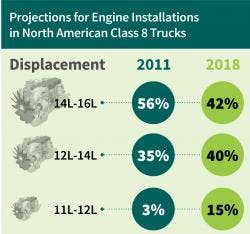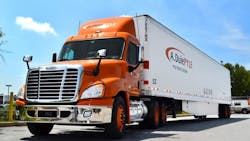If you’ve ever heard the saying “go big or go home” and shook your head thinking there are many situations where it really doesn’t apply, welcome to the evolution of heavy-duty trucking in North America. Engine and powertrain technology has progressed to a point where more is possible with less, and there are a number of other factors also coming into play. It’s all helping drive a move by more trucking companies away from a 14-15L engine standard toward a 13L sweet spot, and increasingly to the 9-12L range.
“The old bread and butter isn’t the bread and butter anymore,” says Frank Trzaska, director of maintenance support at third-party logistics company NFI Industries, one of three fleets Fleet Owner spoke with on the topic. In an industry where companies have been finding ways to shave off little slices of excess and chase down incremental gains in efficiency, particularly when it comes to fuel consumption and mpg, is it any surprise fleets are considering smaller-displacement engines?
And you don’t have to look far for options: Cummins Inc. calls its 11L ISM “one of the flagship engines” of its heavy-duty product line; Paccar launched its MX-11 of that same displacement in North America last fall; Mack says its MP7 11L is “the light engine that packs a punch”; and Volvo notes that its D11 can minimize costs of operation, to name several heavy-duty powerplants south of the 12L mark. All four of those, incidentally, can be spec’d with upwards of 400 hp. and 1,500 lbs.-ft. of torque.
More than meets the eye
“We call it ‘powertrain downsizing’ or ‘engine downsizing,’ if you may,” notes Sandeep Kar, global director of commercial vehicle research at economic consulting group Frost & Sullivan. With technology advancements, he tells Fleet Owner, “what’s happening is we’re creating a foundation where engines will be smaller in displacement yet will not compromise on power output, which means power density is increasing.”
Kar is quick to point out, however, that 15L engines aren’t going anywhere. “On the contrary, 15L engines will remain the industry leader in terms of installations, but the share they hold will decline.”
And why is that?
First, smaller engines can offer higher fuel efficiency, lower acquisition cost, and essentially the same power bandwidth as larger engines, Kar contends, especially when paired with today’s automated manual transmissions. But beyond that, what “doesn’t meet the eye” is that OEMs like Daimler, Volvo and Paccar are introducing engines in ranges like 12-13.5L in efforts toward vertical integration, he says. In other words, they’re looking to gain market share with their own products against Cummins’ widely popular ISX15.
“So fleets can carry more freight and more payload because of the light weight, and the trucks are more fuel-efficient because of the OEM proprietary engines married with OEM proprietary transmissions that give interesting fuel economy benefits,” says Kar. “And fleets love that.”
Frost & Sullivan has also found that more fleet managers of the nation’s top 100 fleets say they’re “okay with the idea” of same-sized trucks with smaller-sized engines—that was 20% of fleet managers surveyed in 2012 and 33% in 2014. “But had I asked this question 10 years ago, the figure probably would’ve been 2-3%,” Kar says.
Another factor is the Panama Canal expansion project, which started in 2007 but is now mostly complete. “All those mega container ships that used to come to the Western Seaboard will now come to the Eastern Seaboard; hence, we will not need to rely on long haul as much,” Kar explains.
“We’re looking at the rise of regional haul at the expense of long haul,” he adds. “So the long-term outlook for smaller-sized engines is definitely promising.”
One size doesn’t fit all
Start with a less-than-truckload (LTL) carrier fleet operating in the Northeast like A. Duie Pyle, where all you’ll find are 11L and 13L diesels in single- and tandem-axle tractors, respectively. The 11L tractors are used primarily in a pickup-and-delivery operation and occasionally in line haul, says director of fleet maintenance Dan Carrano, while the larger-engine tractors are used both for line haul and pickup-and-delivery operations.
“Aside from being an LTL carrier, we also have a liquid bulk operation where we must achieve a precise load capacity,” he notes. In that operation, the Pyle trucks have a gross combination weight (GCW) of about 100,000 lbs., Carrano says, “and we’re more than able to move that load with a 13L engine.
“But we have not had one experience where we’re underpowered, even with our 11Ls,” he continues. The 11L trucks run a GCW up to 66,000 lbs., “and that 11L is more than powerful enough to meet our expectations. Our goal is to spec the right equipment for the right application—it’s not a 'one size fits all' in our eyes.”
NFI Industries, on the other hand, operates nationally and has found more of a sweet spot with 13L engines, which you’ll find in nearly all the fleet’s tractors along with “a handful” of 9L CNG-powered engines. “Everything we could think of, for every avenue we went down, a 13L worked for us, and it worked well,” says NFI’s Trzaska. “We have a 450-hp. 13L, where 20 years ago we were running 350-hp. 15Ls,” he points out.
“Today, there’s plenty of horsepower and torque in those 13Ls, and it’s in the low rpms—it’s in a great range—to power 80,000-lb. gross vehicle weight down the road all day,” Tzaska explains. NFI also specs direct-drive, automated manual transmissions, “and these 12-speeds can shift all day long, up and down, constantly, where a driver would be worn out come the end of the day from all that shifting.
“So today we can have a smaller engine with a smaller powerband and less horsepower [compared with the latest 15Ls], and it does the exact same work,” Trzaska adds. “And our driver is just as fresh when he’s done with his day as when he started it. That transmission will keep that engine in that tight powerband he needs and operate the truck efficiently for mpg, engine life, and proper speed. For our fleet, there’s no sense in thinking about a larger engine for any of our operations anymore.”
Or take a company with very diverse equipment like Ryder, where “we have every possible configuration of engine and chassis out there in our fleet,” according to Scott Perry, vice president of supply chain management. Among its heavy-duty trucks, Ryder has some 9L and 11L engine variants as “pretty rare exceptions,” he notes, with “the vast majority” sporting 13L, 14L and 15L configurations.
“We’re seeing really good performance out of our 13L platforms, but we’re still very disciplined in making sure that we’re putting them into the right applications,” Perry says. “We generally don’t put a 13L engine in a sleeper tractor. We stick to a 14-15L heavier, higher-displacement engine in those just based on the types of duty cycles that those trucks could end up in.
“We’re also very conscious of the GCW limits, and that probably applies more to our Canada operation,” he continues. “We make sure we don’t put a 13L engine in anything higher than an 80,000-lb. GCW application.”
Pros and cons
Geography and type of trucking application—e.g., the A. Duie Pyle LTL, Northeast-region model—are primary considerations when considering how to rightsize engines for your equipment, but there’s more to it than that. More heavy trucks are ending up having to go through local communities and neighborhoods, for instance.
“A lot of areas we deliver in were designed for 40- and 45-ft. trailers,” Carrano notes. “So we always consider the length of the trailer and the size of the tractor. We’re looking for the right piece of equipment for the right application, and you have to consider things like infrastructure and roads; we’re always looking to help set our drivers up for success.”
Smaller engines and the tractors to house them also are a factor at NFI, both in terms of agility and lighter weight of equipment, which means more freight/payload capacity and better mpg. “A shorter hood on a tractor also gives the driver better visibility and maneuverability when he’s parking behind a warehouse or pulling in to a storefront,” Trzaska tells Fleet Owner. “It’s just much easier and safer to drive around all the other things on the road.”
Lighter, smaller-displacement heavy-duty engines in the 9-13L range today can have plenty of horsepower and torque —in some cases surpassing the larger-displacement engines of yesterday—thanks to things like better oils and the use of new materials like compacted graphite iron. They even have maintenance intervals and life expectancies similar to or equal to their bigger siblings.
“Like the Paccar MX-13 engine, the MX-11 has a rated B10 life of 1 million mi.,” says Charles Cook, marketing manager for vocational products at Peterbilt. “This means the MX-11 engines are designed and tested that 90% of the engines produced will reach 1 million mi. without a major overhaul.”
Those smaller engines may even offer a few maintenance advantages, points out Mario Sanchez-Lara, director of on-highway marketing communications at Cummins. With the company’s medium-bore, heavy-duty engines like the ISL9, ISM and ISX12, “in general, their maintenance intervals are shorter [vs. 13L and larger engines], but the cost of some aspects of it is more cost-effective. Smaller engines on a big chassis offer lots of space with great serviceability,” he says.
However, smaller engines still don’t hold up quite as well in terms of residual value in the secondary market, Fleet Owner heard. That was once the case for 13L engines, though the market largely has warmed to those now, but it remains the situation for smaller engines like 11Ls, according to Trzaska. Owner-operators shopping the used-truck market once “didn’t believe that a 13L could do everything, because they had to have a truck that could do anything at any time—those guys were always looking for the high horsepower, big engine that would last forever.”
“You get a 13L, and it’s 300 lbs. lighter than a 15L; an 11L could be 400 lbs. lighter than that,” he adds. “Owner-operators figured that out. They’re businessmen today. They figured out that by rightsizing their engine, they can shed hundreds of pounds that they can put into payload and charge somebody for.”
The green argument
The three fleets we spoke with all said a smart strategy is to know your application, location and duty cycle, and rightsize—not oversize—your engines for the job. Like Ryder does now, NFI and A. Duie Pyle said they wouldn’t hesitate to spec larger 14-16L engines if the job called for them.
And while NFI’s Trzaska said that in its experience and real-world use, the company wasn’t able to get more fuel economy out of an 11L vs. a 13L engine, there’s also the argument of lower overall emissions. For some companies, Ryder’s Perry points out, smaller-displacement engines could be a differentiator in a highly competitive industry.
“There’s organizations that will definitely leverage that and will focus on that to differentiate themselves with regard to how they’re designing their distribution networks and making sure they have the most efficient powertrain available,” Perry says. “So private fleets with their brand on the truck, for example, if that’s part of their messaging to the marketplace, they definitely will want to pay attention to that and make sure they’re making those good, informed decisions.”
About the Author
Aaron Marsh
Aaron Marsh is a former senior editor of FleetOwner, who wrote for the publication from 2015 to 2019.




